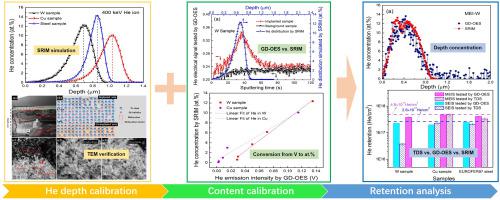Spectrochimica Acta Part B: Atomic Spectroscopy ( IF 3.3 ) Pub Date : 2021-07-20 , DOI: 10.1016/j.sab.2021.106257 Li Qiao 1 , Ran He 1 , Xuexi Zhang 2 , Hong Zhang 1 , Peng Wang 1

|
In order to quantitatively study the retention behaviors of helium (He) in the fusion relevant materials by Glow Discharge - Optical Emission Spectroscopy (GD-OES), tungsten (W) and copper (Cu) samples were implanted by He ions with different energies and fluences, and the He distributions in these samples were investigated by transmission electron microscopy (TEM) and simulated by the Stopping and Range of Ions in Matter (SRIM). After that these He implanted samples were used as calibration samples, and the electrical signal of GD-OES measurement was converted to He concentration depth profile. The results show that TEM investigations are consistent with SRIM simulation at the maximum concentration distribution depth of He. The experiment also found that He diffusion in the material is obvious, beyond the prediction range of SRIM simulation. After calibration, the He depth profiles in multi-energy implantation W, Cu and EUROFER97 samples measured by GD-OES agree with the SRIM simulation. GD-OES and thermal desorption spectroscopy (TDS) independent experiments proved that the total retained He amounts in materials are close to the total implanted He amounts, indicating that using He-implanted standard samples combined with SRIM simulation to obtain GD-OES depth profile is reliable.
中文翻译:

通过辉光放电发射光谱法测量的面向等离子体材料中的氦保留深度分布
为了通过辉光放电-发射光谱法(GD-OES)定量研究氦(He)在聚变相关材料中的保留行为,钨(W)和铜(Cu)样品被注入不同能量的He离子和通过透射电子显微镜 (TEM) 研究这些样品中的 He 分布,并通过物质中离子的停止和范围 (SRIM) 进行模拟。之后这些He注入样品被用作校准样品,并且GD-OES测量的电信号被转换为He浓度深度剖面。结果表明,TEM 研究与 SRIM 模拟在 He 的最大浓度分布深度一致。实验还发现He在材料中的扩散很明显,超出了SRIM模拟的预测范围。校准后,GD-OES 测量的多能量注入 W、Cu 和 EUROFER97 样品中的 He 深度分布与 SRIM 模拟一致。GD-OES 和热解吸光谱 (TDS) 独立实验证明材料中总保留 He 量接近注入 He 总量,表明使用 He 注入标准样品结合 SRIM 模拟获得 GD-OES 深度剖面是可靠的。


























 京公网安备 11010802027423号
京公网安备 11010802027423号